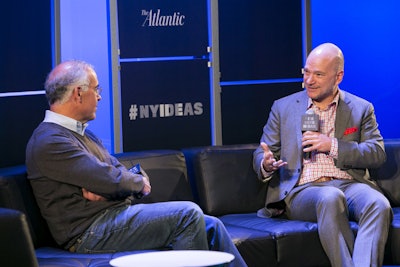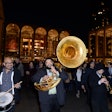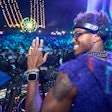
This is the first column by Chad Kaydo (@ChadKaydo), BizBash’s former editor in chief and the founder and editor of The X Letter, a website and newsletter about experiences, brands, and culture. Chad’s column will now appear biweekly.
Last week at the New York Ideas conference hosted by The Atlantic and the Aspen Institute, New York Times columnist David Brooks interviewed Andrew McAfee, a co-founder of M.I.T.’s Initiative on the Digital Economy and co-author of The Second Machine Age.
They discussed how digital technologies are transforming so many industries, leaving swaths of people in certain professions increasingly obsolete—even in white-collar fields like medicine, law, and (ahem) journalism.
At one point Brooks gestured to the crowd of swells gathered to hear “innovators” and “thought leaders” talk about everything from cronuts to cancer treatments, and asked, “Will this go away?”
McAfee did not like this notion. “There is no substitute,” he said. People need to gather to exchange ideas. “It would be dire, dire, if that went away.”
McAfee made another apt point in an auditorium where people shifted back and forth from watching the folks on stage (Gabby Giffords, HBO C.E.O. Richard Plepler) to checking their various small-screen devices. (A woman next to me typed out a couple emails on her iPad during one talk.) The world constantly tempts us with distractions, McAfee said, and we must take a stand, put away our iPhones, and engage with other humans.
Which brings us to my topic here: the peculiar challenges and the very necessary role of live gatherings in this modern age.
That’s what I intend to focus on in my new biweekly column for BizBash, along with the big and small trends that arise as we respond to those challenges. How can we create compelling live experiences?
Let’s start with three elements that have always been intrinsic to live events, but are increasingly important in our digital age: content, community, and collaboration.
Content
This has always been the meat of any event—the information shared, the product launched, the vows made—but now content also refers to the tweets, videos, photos, and blog posts that follow. As social media creates a vacuum for brands (“Look, we have a Tumblr/Instagram/Vine … now what do we do with it?”) many look to events to feed the beast. Meeting and conference hosts admiring the programming carefully curated for their in-person attendees are thinking, “Shouldn’t we record this, archive it, and share it?” Doing that well is harder than it looks, but the people watching TED Talks online 1.9 million times a day get lots of event hosts excited.
For events where content wasn’t always king—let’s call them “parties”—organizers know their gatherings now need to justify their existence from every angle: to hosts, sponsors, and attendees, all questioning how they want to spend their money, time, and attention. Relevant, compelling content often helps make that case.
“When we work on the content piece at Fast Company, I’m thinking constantly about, what is the takeaway and what can the audience get out of this,” says Kim Last, the magazine’s senior events editor. (She’s in charge of programming, while a separate team handles logistics—which shows how much Fast Company, which won the Magazine of the Year award from the American Society of Magazine Editors a couple weeks ago, values event content.) “I like to have things that are really image-driven, or things that the audience can try for themselves afterwards. As much as I love hearing people talk, you have to hook people in other ways too.”
Community
During a New York Ideas panel about pop-up shops, the fashion blogger Garance Doré (also the subject of a Times Style profile last week) recalled that when she launched her stationery line, she was more interested in hosting a pop-up for fans of her blog than holding a dinner for fashion editors. The whole panel agreed that while independent designers can now build a fan base online, physical retail space allows them to create a deeper brand experience that helps customers feel like part of a community.
Even as technology transforms live events, the core strength of gathering people in one place is the power that comes from sharing an experience, meeting people with some common interest, and feeling part of a larger group.
So how do you make that happen when everybody’s staring at a phone?
Ironically, one proposed solution is using conference apps that mimic popular social networking platforms to connect people. But that means convincing people to add one more icon to their screen. “When you have a conference of 600 people, I’m always asking, 'How can people get to know each other quickly?'” Last says. And yet, “I don’t really want to download an app that I’m not going to use again,” she says, and I think she’s on to something.
(At another conference where I spoke recently, an announcer reminded attendees to download its app after every single speaker. I still didn’t do it. I did, however, tweet at another speaker, and we had a great lunch. To each his own.)
Among the low-tech ways to encourage interactions: keeping a loose schedule with time for unexpected conversations and creating comfortable environments where people can huddle up and talk.
Angela Brown, the event director for the Linux Foundation, who runs events for the programmers from around the world who contribute to its open-source system, talked to me for a BizBash story last year. “One of the things we always key in on is we need a ton of foyer or lounge space,” she said. “There's always going to be people who are going to choose to have that face-to-face collaboration instead of sitting in sessions.”
For my money, the best way to create the second C is to deliver on the first: Produce strong content, and help attendees become a temporary community with a shared experience. (Think about how a funny movie feels even funnier in a theater full of people laughing.) Give them something to talk about, a reason to turn to someone else and say, “Wasn’t that cool?”
The best way to curate the content might be to focus on the third C, which may be the toughest—and scariest—for event hosts.
Collaboration
While gatherings like hackathons exist entirely to help attendees work together, most events are structured around the idea of a one-way flow of information, from host to guest.
But so much research about millennials says they prefer a more democratic approach to sharing information, and so many digital platforms are dominated by a culture of collaboration, of people liking and sharing and commenting and reblogging and recording a response to that YouTube video.
At the Green Meeting Industry Council’s Sustainable Meetings Conference in San Francisco in April, conference facilitator and author Adrian Segar led a session where attendees created presentations that encapsulated what they learned from 11 tours of local green facilities. Each team got a cardboard box, markers, and tape, and added photographs and things they had picked up on their tours. An architect used the boxes to make a 90-foot bridge—the theme was “Bridge Building”—as a physical learning module. “You need a concrete expression of things that people do at meetings,” Segar says.
I’ll say the attendees formed a community to collaborate on content.
Collaboration isn’t just something that happens at events—it can also help lead the creation of the event itself. Segar is a longtime proponent of having conference attendees choose the topics that interest them most, and a facilitation style where you learn from the expertise of the entire group, not just a preselected set of speakers.
Meanwhile, the collaborative culture of the digital world has led to platforms for people who want to create their own events. Meetup has more than 140,000 groups. A search for “festival” projects on the crowdfunding site Kickstarter this week yields more than 2,500 results; “conference” yields more than 150.
Kickstarter C.E.O. and co-founder Yancey Strickler spoke at New York Ideas, too. He said something in a conversation about how users choose which projects to fund that sounds like a good lesson for professional event planners nervous about turning over the reins to their attendees: “I think a lot of the cynical perspective on this assumes that audiences are sheep. But I think audiences are smart.”
Kickstarter and Meetup are known for grassroots events that are mostly scruffier than their slick, corporate counterpoints—there’s no crowdfunded Met Gala yet. But I think they offer a warning for event hosts not interested in listening to their constituents: If you’re not creating something that your audience wants to participate in, they might just go around you.
In other words, if your content isn't creating a community, your guests might just collaborate and do it themselves.



















